The Methall Hoard – by Gaenor Rudall, Numismatics Volunteer
YMT volunteers Gaenor Rudall and Olivia Farrow recently gave a talk at the Yorkshire Museum on the Methall hoard, a group of Roman coins that they’ve been documenting for the past nine months. Here’s a taste of what they said…
The hoard was discovered in 1856, at Methall Hall Farm near Nunburnholme, a few miles east of Pocklington. It had been dug up by a farmer while ploughing a field, and originally contained over three thousand coins. The Yorkshire Museum now has 798 of them. The pot they were buried in has long since disappeared, but the farmer described it as a large pancheon.
This is a traditional shape of bowl, usually quite wide and with straight sides which slope outwards – an odd choice if you were intending to bury your cash in the hope of digging it up again later. It may be that the bowl was simply placed on the ground as somewhere for people to leave their loose change, as a communal offering to the gods.
All the coins are the same type, which we call radiates after the type of radiated crown the emperors are wearing. They’re made of copper alloy with only a very small percentage of silver, and they date from around 253 to 274AD.
These radiates were virtually the only coins in general circulation in Britain at the time, and tens of thousands have been found here. They were minted in Trier and Cologne, in present-day Germany, where it’s thought that up to a million coins were produced each day! We have to admire the organisation that must have been required to achieve this.
Many of the coins in this hoard are in poor condition, and probably weren’t of the best quality to start with. Here are three of them, as examples of the variety we came across:
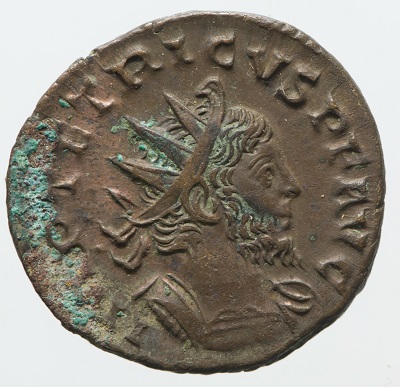
Radiate of Tetricus I. Obverse legend reads IMP TETRICUS PF AVG. (YORYM:2016.301.322).
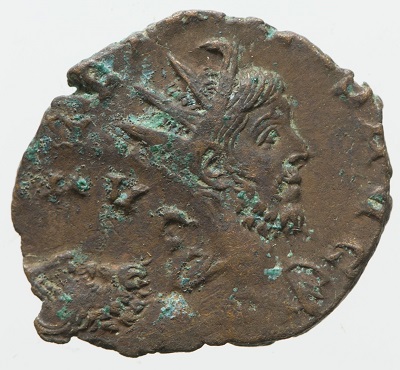
Radiate of Tetricus I. Double struck. Obverse legend largely illegible. Reads [] TE[] AVG. (YORYM:2016.301.431).
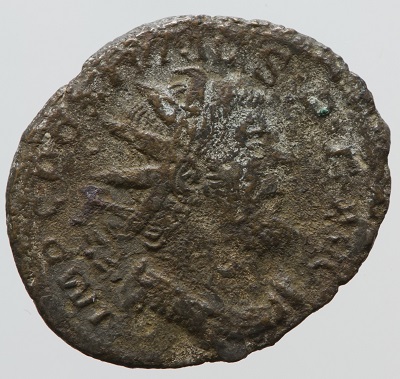
Radiate of Postumus. Very worn. Obverse legend reads IMP C POST[]MUS PF AVG. (YORYM:2016.301.20).
The first coin, minted by Tetricus I, is reasonably well made and preserved, but the second has been double-struck – note that Tetricus’ profile with beard is repeated, on its side, at the bottom left. The third coin is very worn, as are many in this hoard, and represents Postumus. He was the founder and first emperor of the breakaway Gallic Empire.
Almost all the coins in our hoard were made within this empire, which consisted of Gaul, Britain, part of Germania and, to start with, Spain. It was created at a time when the Roman Empire was being attacked on several fronts, and the emperor Gallienus was forced to deal with a succession of rebellions. He left his general Postumus in charge on the northern Rhine frontier.
Postumus proved to be a very capable military commander, and in the year 260 his men proclaimed him emperor, establishing this independent empire. He set up an administration based on Roman government, including minting his own coins. Producing coins that were virtually identical to the official Roman coins was a very good way of legitimising his position and of rapidly spreading the new emperor’s name.
Postumus was in power for around 9 years, which at the time was quite good going! But by far the largest number of coins in our hoard were minted by Tetricus I, who ruled from 271 to 274 with his son, Tetricus II as co-regent. By this time the coins were of very poor quality, with only around 1% silver.
None of the Gallic emperors were ever officially confirmed by the Roman senate, who called them tyrannus or tyrant, meaning someone who had taken power illegitimately. And in 274 the Gallic Empire came to an end when the main Roman emperor, Aurelian, defeated Tetricus’ army – it’s thought that Tetricus senior and junior may have defected to the other side, leaving their own army to be cut to pieces.
Aurelian took them prisoner but spared their lives. Rather unusually for former Roman emperors, they went on to have later careers – the father became governor of Lucania, a province just to the south of Naples, and his son became a senator in Rome.
Aurelian then set about reforming the Roman currency. The mints used by the Gallic Empire had been destroyed, and during this time of shortage many copies were produced, though we have no way of knowing exactly where.
Here is an example of a very obvious fake, with its crude features and simple lines to represent lettering:
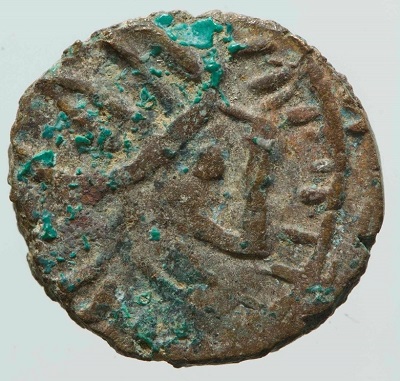
Contemporary copy of a radiate. Obverse. Stylised portrait and writing. (YORYM:201.301.774).
The reverse of the coins can say as much about the period as the obverse does, especially in terms of the messages the emperors were trying to promote. A large number of our coins have images with a recurring theme, that of positivity and happiness. Here are four of them, depicting Pax, Salus, Laetitia and Fides:
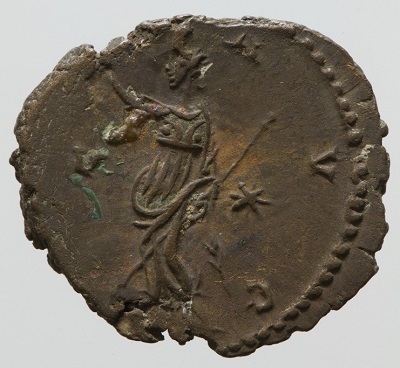
Radiate. Reverse depicting Pax. Legend reads PAX AVG. (YORYM:2016.301.42).
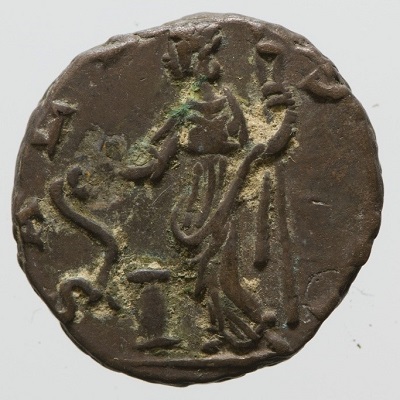
Radiate. Reverse depicting Salus. Legend reads SALVS AVG. (YORYM:2016.301.62).
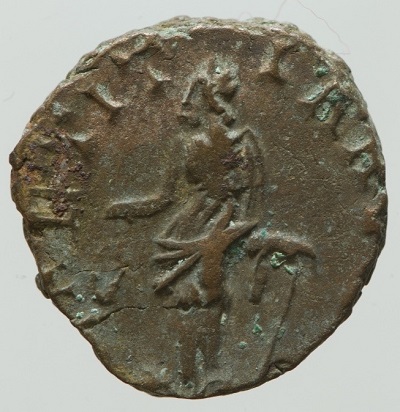
Radiate. Reverse depicting Laetitia. Legend reads LAETITIA AVG. (YOYRM:2016.301.511).
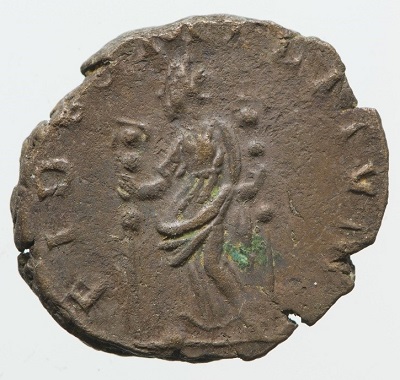
Radiate. Reverse depicting Fides. Legend reads FIDES MILITVM. (YORYM:2016.301.405).
The images are very standardised and the figures shown on them look very similar, but they can be identified by what they carry. Pax, at the top, holds an olive-branch and represents peace. Salus was the goddess of well-being and welfare. She was the daughter of Aesculapius, the god of healing, and is shown here with one of her father’s sacred snakes.
Laetitia represents joy or rejoicing, and is sometimes shown with an anchor to represent stability, or with a ship’s rudder to steer towards prosperity. And Fides, the goddess of trustworthiness and good faith, is holding two military standards to reassure people that they were well defended, and to remind the army of the solemn oaths they had taken when they joined up.
After the Gallic Empire ended, its coins soon had very little value, and many of the large hoards which had been buried were left in the ground because it wasn’t worth the bother of digging them up again. Examining and documenting them allows us a valuable insight into the past, as our connection to a distant era and to help us understand the values and messages that were important to emperors and also to ordinary citizens.
Curator’s Talks are delivered at the Yorkshire Museum on Tuesdays from 12.30-1pm, and are free with admission. Upcoming talks can be found on the Yorkshire Museum website.


Your Comments
Rosie Faith-Strutt |
Brilliant – very informative